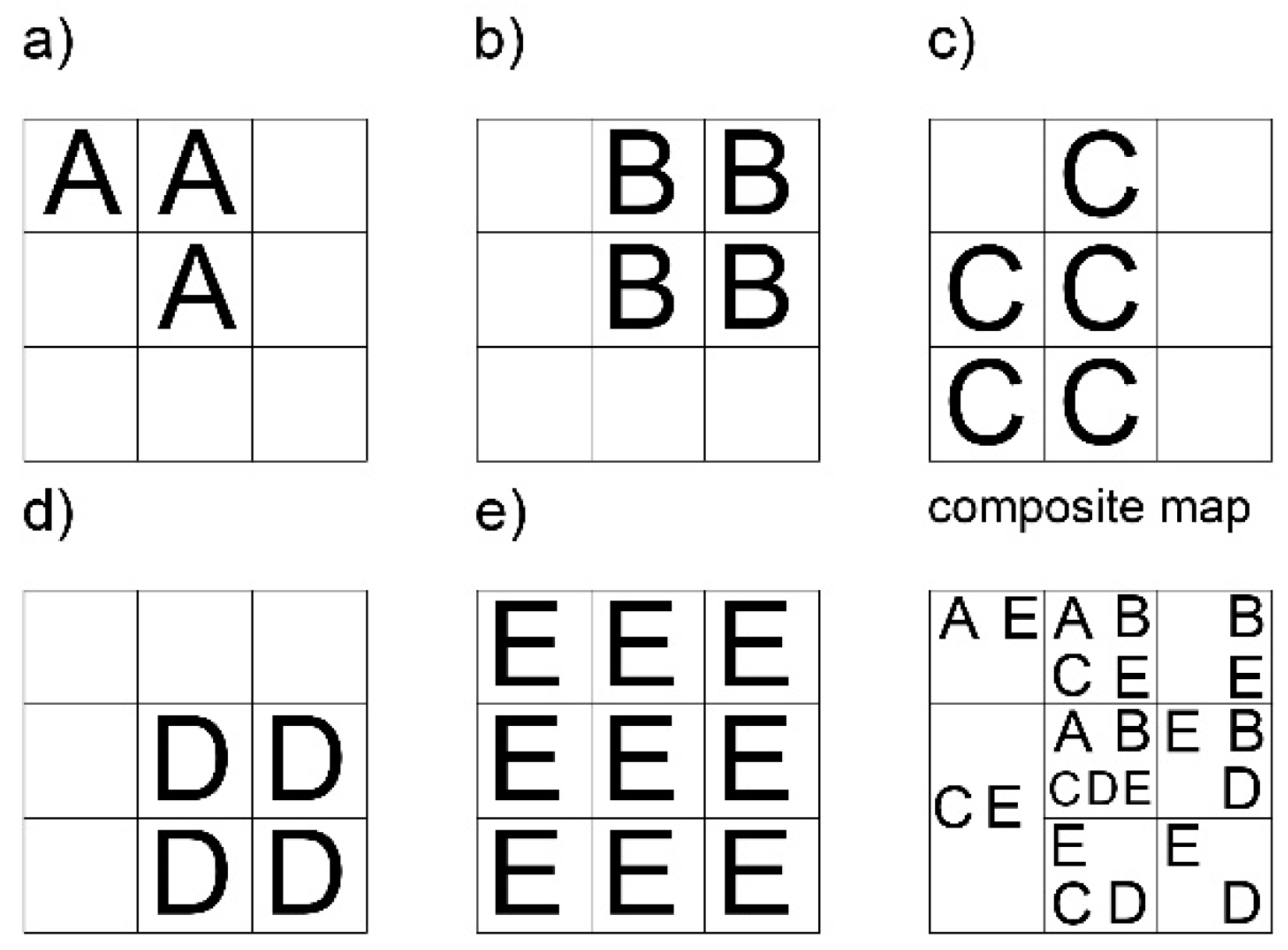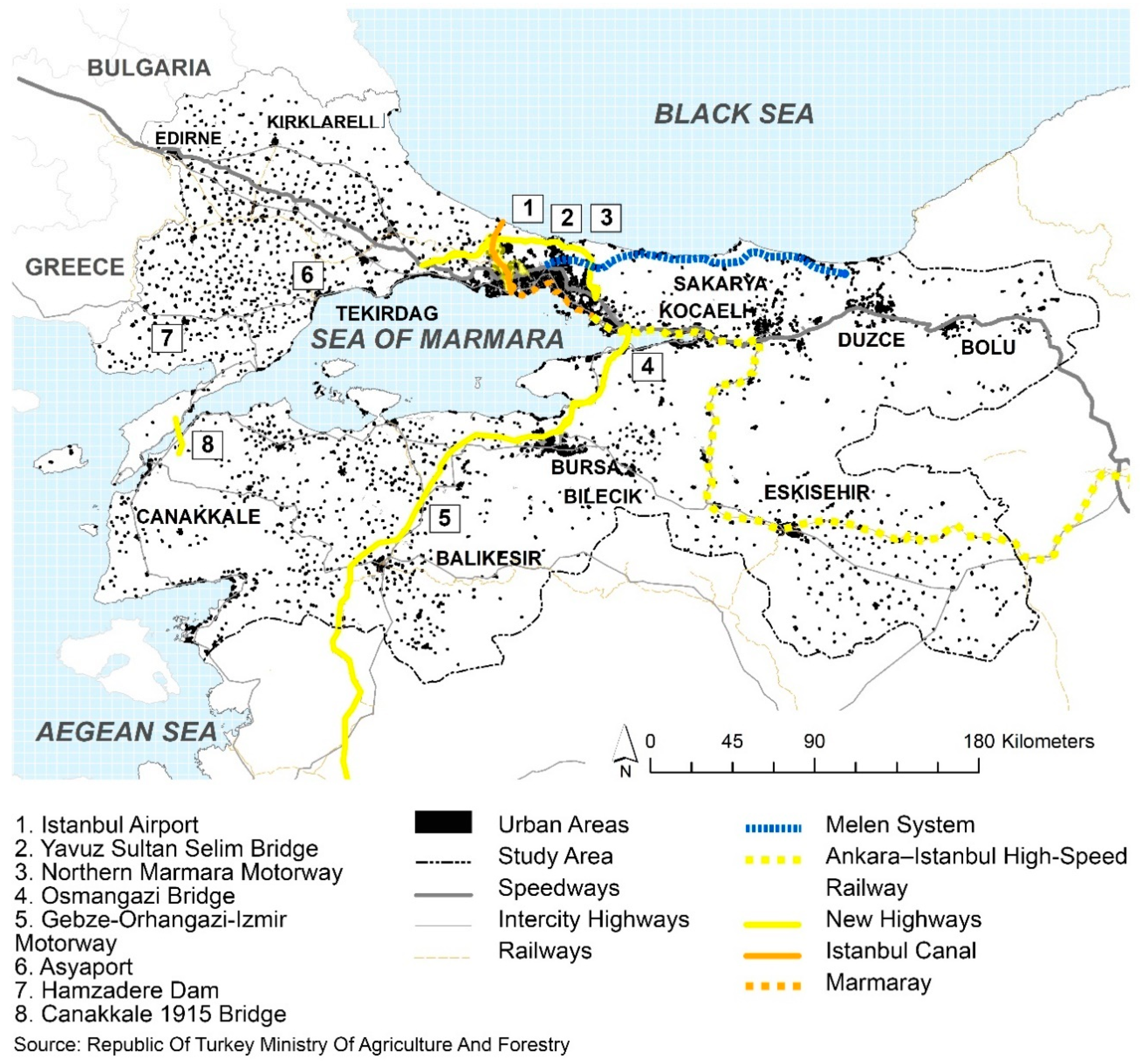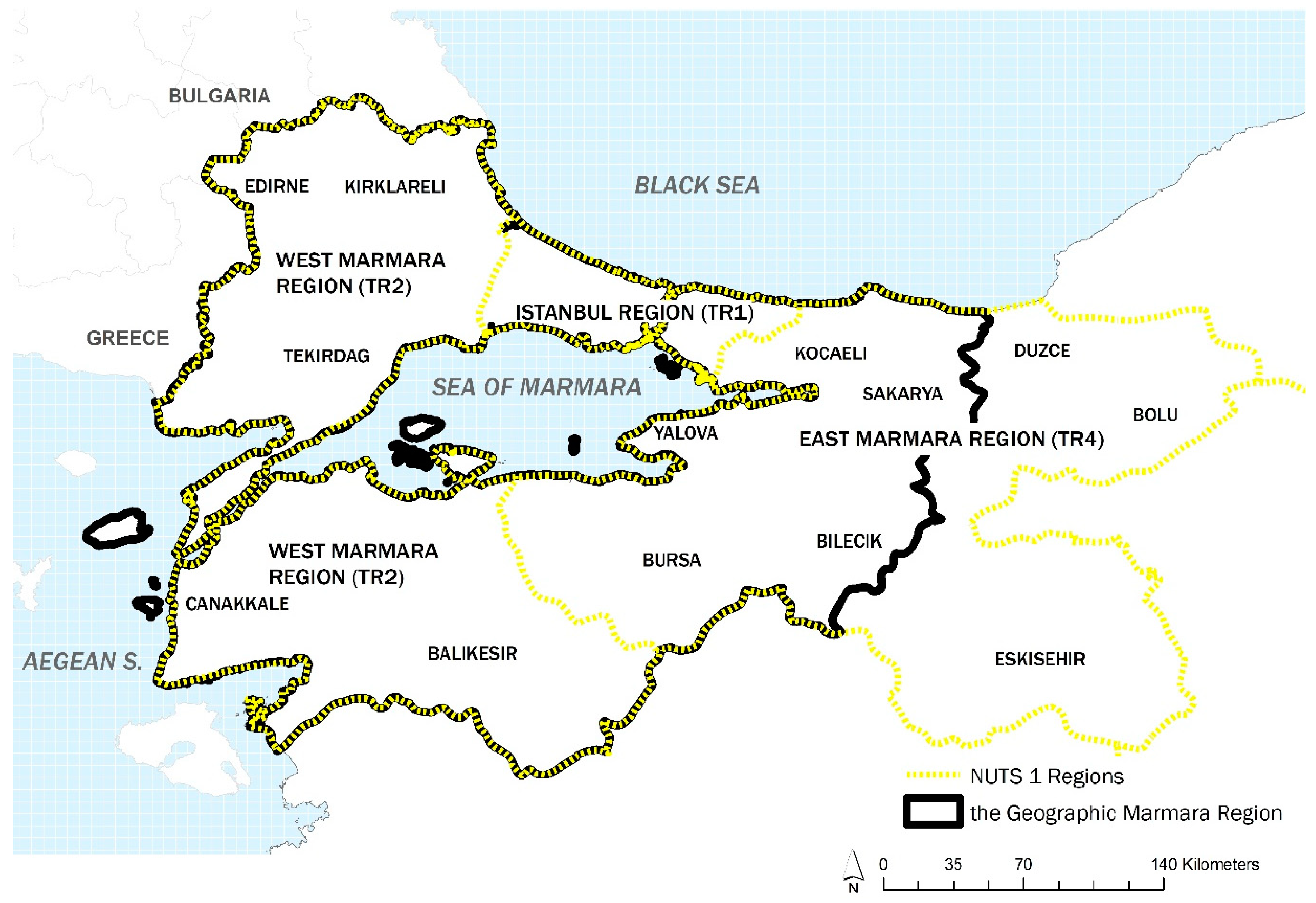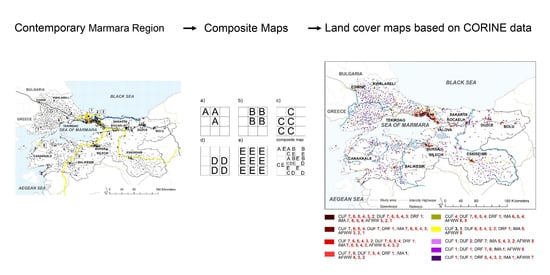1. Introduction
Urban regions are being shaped by increasingly rapid expansion and densification, accompanied by efficient communications, transportation systems, and economic activity [
1,
2]. In 2018, the United Nations predicted that 68% of the world population will live in urban areas by 2050 [
3]. To achieve current sustainable development goals, all stakeholders urgently need to understand the spatial and temporal transformation of contemporary urban regions. However, there is a gap between contemporary urban planning theories and practices, which hampers decision-making processes. The availability of new data analysis and mapping techniques can fill this gap, which potentially threatens urban regions’ sustainable development.
Beginning from the early 20th century onwards, urban regions’ complex urbanization dynamics have been a central debate in the urban planning and geography disciplines [
1,
2,
4,
5,
6]. Studies of urban regions questioned the validity of a clear morphological separation between polycentric and monocentric models [
7]. Other studies analyzed the complexity and hierarchy of cities and towns [
8,
9,
10,
11], in which regional policies, population, accessibility, social and economic indicators, and infrastructural investments shape urban development [
12,
13,
14,
15,
16]. However, the sustainability challenges of urban regions, stemming from rapid spatial transformation, have demanded a greater focus on the land use/land cover (LULC) change of these areas [
17,
18].
Within the literature of LULC studies, urban regions’ intra-regional variations are a critical component of the analysis [
13,
19]. Recent studies on landscape metrics have effectively investigated the spatial–temporal transformation of urban regions by capturing the complex urbanization patterns in different geographical contexts, for sustainable land use policies [
20,
21,
22,
23]. Other LULC studies have used different analytical approaches [
24,
25] to demonstrate that rural areas, beyond urban fringes, are subject to more dynamic spatial transformation than urban cores under the same pressure of regional urbanization. Such findings undermined the validity of urban/rural division and administrative borders in assessing regional urbanization, and revealed the wide-felt urgency for new theoretical concepts.
Research in urban theory recently reformulated the holistic “planetary urbanization” approach [
26] to comprehend territorial urbanization beyond an urban/rural division. This literature, however, avoids systemic non-theoretical descriptions. To assess “complex entities” such as regions in geography, Gray [
27] stresses the crucial need to create concepts via categorization. In Gray’s method, exploratory analysis and composite maps are imperative for categorization. According to Gray, these composite maps should convey the complexity of spatial data (such as land cover) beyond homogenous concepts, however, he does not define an analytical procedure to generate such maps. Recent progress in data analysis has facilitated data categorization. Lebart’s [
28] method on “complementary use of correspondence and cluster analyses” is an exploratory (unsupervised) data analysis technique that can be used for data categorization. The complementary use proposed by Lebart minimizes the methodological problems of both correspondence analysis and cluster analysis, and thus enables the generation of composite land cover maps based on data categorization.
Despite these theoretical, empirical, and methodological advances; some areas in the study of urban regions demand more scrutiny. First of all, the indirectly proportional relationship between comprehensiveness and resolution in mapping is a challenge for urban regions’ cartographic representation [
27]. Regional scale demands comprehensive maps, yet urban areas cover a small portion of the regional scale, meaning such maps should have adequate resolution to capture spatial intra-regional variations, and they should also be visually communicative. Furthermore, to reflect the spatial intra-regional variations, regional maps should avoid thematic uncertainty and over-generalized legends. Second, the sustainable spatial development of urban regions demands coordination between regional policies and planning interventions. Despite the recent advances in sustainable land use planning, contemporary regional policy and planning practices lack clear guidelines for connecting research and practice.
These theoretical, representational, and planning challenges for urban regions materialize in the Marmara Region, which is Turkey’s most densely populated, ecologically diverse, and economically advanced region [
29]. Despite the infrastructure investments, legislative changes, and rapid urban development in the Marmara Region, and particularly in Istanbul since the 2000s (
Appendix A), few studies have addressed the regional urbanization in this area [
30,
31,
32]. While this rapid regional urbanization has raised environmental concerns [
31,
33], neither Istanbul’s contemporary urban sprawl at a regional scale, nor the Marmara Region’s contemporary urbanization patterns have been systematically studied.
Correspondingly, very few studies have assessed the LULC change of larger systems of urbanization in Turkey beyond the metropolitan scale [
34]. The unavailability or inaccessibility of institutional digital spatial data in Turkey discourages such studies. The CORINE land cover (CLC)’s broad spatial scope, continuous geometry, land cover type diversity, and consistency [
35,
36] facilitates such studies. While high-resolution land cover maps can be obtained via different resources [
37], in contexts with limited data access, CLC, as an institutionally open resource, provides baseline data for regional research and comparative studies. However, the scope and content of CLC data demand further processing.
This paper fills the addressed gap in the literature by deciphering the Marmara Region’s urban transformation between 2006 and 2018, during a transitory period of urban policy and infrastructural development. The research questions are: (1) To what extent can a distinct, integrated intra-regional urban network be identified in the Marmara Region between 2006 and 2018, based on urbanization patterns? (2) Have the simultaneously initiated regional policies and mega-projects effectively addressed the region’s spatial transformation? (3) In what ways can this study’s findings contribute to new approaches and concepts in regional theory for effective urban planning and policymaking?
To answer these questions this study generates composite maps of the Marmara Region based on CLC data for 2006, 2012, and 2018, by utilizing Gray’s [
27] exploratory approach and Lebart’s data analysis model [
28]. These composite maps demonstrate the coexistence and intensity of different urban land cover types, and reveal the complex regional urbanization patterns, providing the much-need spatial framework ignored by the contemporary regional policies and planning interventions. Hence such maps can be utilized as guidelines for sustainable regional policy and planning frameworks. The findings of this study contribute to the theoretical, empirical, and methodological discussions about urban regions by revealing the idiosyncratic patterns and sustainability challenges of one of the world’s fastest-evolving examples.
4. Results
4.1. Urban Fabric Land Cover Composition in 2006
While the land cover maps demonstrated in this section reveal a diverse set of relationships between urbanization patterns and dynamics, we focused on the fundamental patterns at the regional scale. The 2006 map (
Figure 7) shows regional urbanization at the beginning of the study period (
Appendix A). Nine morphological clusters are mapped, ranging from densely urbanized areas to rural clusters with diverse mixtures of land cover groups. Out of the 99,936 cells in the overall land cover data set, the processed set comprises 9064 1-km grid-cells that include at least one artificial land cover type. According to the MCA factorial map (
Appendix B), the first two axes explain two-thirds (64.3%) of the total inertia (dimension 1 accounts for 43.2%, and dimension 2 accounts for 21.1%).
In the 2006 data set, CUF, DUF, and DRF respectively accounted for 5.94%, 6.81%, and 11.37%; IMA accounted for 5.94%, and AFWW for the rest (69.93%) of the total land cover.
Land cover clusters generated from the 2006 data suggest the following four distinctive regional sectors: (1) Istanbul metropolitan area; (2) Poly-centric urban centers in the eastern Marmara Region, comprising Kocaeli (Izmit), Sakarya, Duzce, Bolu, Yalova, Bursa, and Eskisehir; (3) Thrace region in the northwestern Marmara Region; and (4) Southwestern Marmara Region. As opposed to Istanbul and the eastern Marmara Region, Thrace and the southwestern Marmara Region are both predominantly rural. The urban fabric land cover composition in the 2006 map demonstrates that while the first two sectors are composed of land cover categories in which CUF, DUF, and IMA are distinctively over-represented, Thrace and southwestern Marmara are composed of land cover categories in which DRF and AFWW are distinctively over-represented. These four major clusters, illustrated in the 2006 map, demonstrate a fragmented administrative city–region structure. The 2006 map also demonstrates that metropolitan centers and poly-centric urban formations already coexisted in 2006.
4.2. Urban Fabric Land Cover Composition in 2012
The data set for artificial land cover types comprised eleven legends covering 9240 1-km grid-cells.
Figure 8 summarizes the characteristics of this distribution. The first two axes of the factorial map explain 54.81% of the overall inertia. The first dimension accounts for 31.73%, and the second 23.08% (
Appendix B).
In the 2012 data set, CUF, DUF, and DRF respectively accounted for 5.89%, 7.56%, and 11.42%, while IMA and AFWW covered 6.05%, and 69.09% of the total land cover, respectively. When the land cover percentages of the 2006 and 2012 data sets are compared, the most significant change is observed in the share of DUF values, with an increase of 10.87% (0.74 percentage points). Within the overall framework, the significant increase in DUF indicates rapid urbanization and changing urban dynamics at the regional scale. In the 2012 map, four sectors, differentiated by distinctive land cover profiles, can still be detected. However, they were subject to substantial changes within a span of six years, increasing the complexity and hybridity of the regional urbanization. Three primary tendencies can be identified in
Figure 8: increased urban density, urban expansion, and leapfrog urban sprawl. The increases in urban density and urban expansion were primarily observed in metropolitan areas, provincial centers, and districts, while leapfrog sprawl was observed in satellite towns.
Land cover categories in which CUF, DUF, and IMA are distinctively over-represented increased in the provincial centers of Tekirdag, Kirklareli, Edirne, Sakarya, Bursa, Eskisehir, Canakkale, and Balikesir, as was also the case in district centers in Thrace and southwestern Marmara (namely Luleburgaz, Babeski, Corlu, Cerkezkoy, Marmaraereglisi, Kesan, Bandirma, Biga, Can, Edremit, Karacabey, and Mustafakemalpasa) and around the Gulf of Izmit. Due to this transformation that was mainly observed along the major highways, there were significant changes, crystallized in the disrupted rural structure in Thrace (
Figure 9) and the southwestern Marmara Region as distinctive urban nodes. Interestingly, this change was noticed by the policymakers. Therefore, Thrace, Luleburgaz, Corlu, and Cerkezkoy were designated as an industrial axis and primary development area in the 2014–2023 Thrace plan [
79].
The first three legends with the highest CUF, DUF, and IMA values (
Figure 8) also show the dramatic urban expansion in Bursa, the region’s second-largest city, and in and around Istanbul (
Figure 9). Due to significant increases of the same legend categories, leapfrog urban sprawl, the third land cover development typology, was observed within the satellite towns surrounding Bursa and Istanbul.
A substantial part of the land cover transformation between 2006 and 2012 occurred in Istanbul’s northern fringes, the province of Bursa, and southwestern Marmara; all situated near mega-infrastructure projects, either recently announced or under construction. Further environmental degradation can be expected in these areas once these projects are fully operationalized. For instance, a recent World Wide Fund for Nature report estimated that 83 sq. km of land will be opened for development, while 134 sq. km of agricultural land and forest land will be destroyed [
33] if the Istanbul Canal project is carried out.
4.3. Urban Fabric Land Cover Composition in 2018
The 2018 land cover map comprises eleven legends covering 9748 1-km grid-cells (
Figure 10). The first two dimensions of the factorial map explain 45.25% of the overall inertia (
Appendix B). The first dimension accounts for 30.25%, while the second for 15.00%. In the 2018 data set, CUF, DUF, and DRF respectively accounted for 5.46%, 8.21%, and 10.75%, while IMA and AFWW covered 6.17% and 69.40% of the total land cover, respectively. Between 2012 and 2018, DUF increased again by 8.73% (0.66 percentage points), while the shares of CUF and DRF decreased. Istanbul expanded less towards its northern periphery between 2012 and 2018 than it did between 2006 and 2012, demonstrating that land speculation had already started before the construction began on the mega-projects. In contrast to Istanbul, urban sectors adjacent to the city centers of Bursa and Eskisehir expanded significantly. The most striking part of the 2018 maps, however, is massive rural sprawl at the regional scale (represented by the last three legends, in which DRF and AFWW are distinctively over-represented). This pattern increase is observed around two main axes: first, the eastern Marmara axis (including Kocaeli, Sakarya, Duzce, and Bolu) that overlaps with an earthquake fault line (
Figure 11); second, along the Gebze-Orhangazi-Izmir Motorway, and especially around western Bursa (including Karacabey and Mustafakemalpasa).
The land cover transformation between 2006 and 2018 demonstrates that certain patterns of regional urbanization paralleled ongoing mega-infrastructure projects. This development included urban sprawl toward the north of Istanbul, encroaching on the forest lands and water basins, and densification and expansion of linear urban development in southeastern Marmara along the Gebze-Orhangazi-Izmir Motorway, encroaching on wetlands, agricultural land, and forest areas (CORINE, 2018). Between 2006 and 2018, DUF had the most significant change in the overall share of land cover. The changes between 2006 and 2012, and 2012 and 2018 displayed great variance: densification, expansion, and leapfrog sprawl dominated the former, whereas the latter was dominated by rural sprawl. These changes transformed the four distinctive regional sectors into a more hybrid structure, in which dense metropolitan areas, emerging urban centers, and nascent sprawl areas coexist.
5. Discussion
5.1. Key Findings
This study aimed to shed light on the intra-regional variations and transformation dynamics of the Marmara Region’s urbanization patterns. Therefore, the study investigated the region’s urban land cover change between 2006 and 2018, a transition period for urban policy and infrastructural development in the region. The major findings demonstrate four major clusters within the Marmara Region, and Istanbul, the primate city with an oversaturated core, displayed a gapless pattern of expansion toward ex-urban areas that threatens the province’s freshwater systems and forest areas. The second cluster is the urbanized eastern Marmara Region of financially stable and rapidly urbanizing cities, including Kocaeli, Bursa, Sakarya, Duzce, Bolu, and Eskisehir, and which is subject to rural sprawl. The third cluster, Thrace, with its robust rural network, became diluted by the urban development that has expanded inland along the highways. The fourth settlement group, the rural southwestern Marmara Region, witnessed urban densification and rural sprawl along the Gebze-Orhangazi-Izmir Motorway axes.
The land cover analyses between 2006 and 2018 reveal rapid urbanization of the region, formerly comprised of four distinct areas, into a more complex and hybrid structure in which “densification and sprawl” take place simultaneously. These findings are essential to discussing whether simultaneously initiated regional policies and mega-infrastructure projects have effectively addressed these changes. That is, did these policies and projects provide an adequate framework to respond to the emerging spatial dynamics of the region?
5.2. Urban Transformation Dynamics Versus Policy Changes and Mega-Projects
The dramatic changes between 2006 and 2018, particularly the densified district centers in the rural structures of Thrace and the southwestern Marmara Region, and the sprawl along the Gebze-Orhangazi-Izmir Motorway, reveal that former structural differences have rapidly diminished. Thus, the novel, medium-scale, city–region-like governmental units generated by Law No. 2002/4720, Law No. 5449, and Law No. 6360 have failed to adequately capture the degree of convergence on the ground. Likewise, Law No. 6360 cannot be justified on the grounds of the Marmara Region’s rapid urbanization, because, despite the massive change, the rural network within the new metropolitan municipalities, such as Balikesir and Tekirdag, did not immediately gain “urban characteristics”. Meanwhile, Law No. 6306 and the mega-projects have encouraged land speculation and sprawl, specifically in Istanbul’s northern territory, thereby invalidating the Istanbul Environmental Plan.
Moreover, the findings reveal that regional resources in rapidly transforming rural areas are even more endangered by rapid urbanization. Urban sprawl to the north of Istanbul (encroaching on the city’s forests and freshwater systems), the densification and expansion of linear urban development in the southeastern Marmara Region towards the southwestern Marmara Region (along the axis of the Gebze-Orhangazi-Izmir Motorway), occupying wetlands, agricultural land, and forest areas [
45], and the urban sprawl in the eastern Marmara Region along the earthquake fault line pose fundamental sustainability problems. This approach essentially demonstrates that regional resources and sustainability concerns were neglected during decision-making processes, and points to further dissonance between the spatial dynamics of the Marmara Region during the study period and the capacity and scope of the simultaneously initiated interventions. These results verify the findings of recent studies that have criticized the top-down, uncoordinated, and fragmented nature of the aforementioned regional policies and mega-projects [
30,
55,
58,
61,
62,
63,
64,
75]. The coexistence of different urbanization patterns corresponds to the findings of the other studies [
20,
21,
22,
23,
24] that focused on the land use land cover change of urban agglomerations, and providing policy frameworks for sustainable land use development. The coexistence of persistence and dynamic change in the Marmara Region’s rural areas essentially coincide with Salata’s findings on Milan’s urban region [
24].
5.3. Theoretical Contribution and Planning Implications
The study’s empirical findings make a crucial contribution to theoretical debates by demonstrating a hybrid urbanization pattern at the regional scale that is neither polycentric nor dominated by the primate city [
7]. The speed and scope of urbanization in the Marmara Region between 2006 and 2018 also verify the critiques of administrative boundaries’ relevancy as the main unit of spatial analysis to assess contemporary urbanization [
49]. This raises the critical question of how contemporary urban planning and policymaking tools can transform this self-organizing structure to ensure sustainable regional development. More specifically, the findings provide an essential framework for determining how simultaneous densification and sprawl can be used to create a balanced and integrated urban region that does not threaten regional resources.
Here, this study has two key implications. First, land use change is an important signifier of urbanization dynamics and environmental sustainability [
24]. Therefore, effective land use planning should be incorporated into regional policymaking [
91] to avoid fait accompli urban planning applications. Beyond polycentric or centralist models, innovative land use analysis and planning methods must be used [
92] to comprehend the spatial complexity of urban regions.
Second, in developing sustainable regional urban and ecologic development strategies to enhance the development of a balanced and integrated network of cities, policy-makers should urgently invest in actions that facilitate more intensive engagement and dialog between governmental and institutional bodies, such as RDAs and the Marmara Region Metropolitan Municipalities. Furthermore, the region’s urban transformation has transcended its administrative boundaries, thereby endangering regional resources. This perfectly exemplifies the complexities of resource management at the territorial level, demanding transboundary collaboration between regional decision-making bodies [
24].
5.4. Methodological and Modeling Limitations
In this study, we used Gray’s [
27] exploratory approach and Lebart’s [
28] exploratory (unsupervised) data analysis model. We specifically focused on the distribution of urban land in the Marmara Region to understand the region’s urbanization patterns. By adopting these approaches we aimed to obtain visually-communicative and comprehensive composite maps that convey both the regional scale and the detailed intra-regional variations of urbanization patterns. The 1-km grid applied on CLC data (after the test of different grid sizes) enabled an adequate variety for generating morphological clusters that demonstrated the complexity of urbanization dynamics. Hence the 1-km grid facilitated the visualization of the fundamental urbanization patterns at the regional scale to answer the research questions. In the grid-cell analyses, however, the selected spatial unit affected the results. Moreover, the CLC data embodies the MMU (25 ha) and minimum width (100 m) limitations [
35]. For future studies, we recommend the use of higher resolutions, the utilization of alternative spatial data resources, and different spatial scales (essential for areas subject to more dynamic change) [
36,
37].
On the other hand, the scope and consistency of the CLC data sets, and the variety of the included land cover types not only enabled us to track temporal changes precisely but also provided the flexibility to transcend administrative boundaries and the limits of population-based studies to reveal the spatial dimension of the regional urbanization. The diversity of the urban fabric land cover types included in the Level-4 classification of CLC data that differentiates highly urbanized areas, sprawl areas, and low-density rural areas is an advantage in discussing urbanization patterns. However, it should be acknowledged that the variety of land cover types in the CLC data is an obstacle, as it prevents researchers from seeing the hidden structures of distinctive spatial associations. In this regard, more comprehensive studies are needed on spatial pattern recognition techniques and in-depth analysis of international case studies, particularly to elaborate on hybrid regional development patterns and adequately address the sustainable development challenges of these rapidly developing areas.
At this point we need to acknowledge one of the main limitations of this study, that these maps, based on the complementary use of correspondence and cluster analyses, reveal one of the many possible representations of the Marmara Region as a complex entity. This limitation can be overcome by applying different pattern recognition techniques and conducting thorough analyses of other land cover types, such as agricultural areas and forests. Long-term scenario-based models are needed to explore the causal inferences of the policies enacted in 2012.
Finally, it should also be acknowledged that while our study was limited to understanding the spatial transformation of urban regions, another important body of knowledge highlights the relationship of urban networks with infrastructural [
93] and societal networks in urban agglomerations.
6. Conclusions
By utilizing Gray’s [
27] exploratory approach and Lebart’s [
28] exploratory (unsupervised) data analysis model, this study analyzed urban fabric land cover change in the Marmara Region between 2006 and 2018 to explore the relationship between urban regions, mega-projects, and regional policy, and highlighting the critical importance of land use planning for sustainable regional development. The complementary use of MCA and cluster analysis enabled the investigation of the patterns and extent of urban land cover distribution regionally by projecting the Marmara Region’s distinctive urbanization dynamics. From the above discussion, we can conclude that, by utilizing this model, the study identified a unique urbanization pattern at the regional scale, which contributes to critiques of solely polycentric or centralist models [
7] in regional planning. We found that simultaneous densification and sprawl within Turkey’s Marmara region indicates the complexity and hybridity of contemporary regional formations. Our findings demonstrate a dissonance between the spatial dynamics of the Marmara Region during the study period, and the capacity and scope of the simultaneously initiated regional policies and mega-projects. This uncoordinated approach has further endangered the region’s sustainable development. This unique urbanization pattern at the regional scale also revealed the speed and scope of “planetary urbanization” [
26,
49]. All these findings demonstrate that it is imperative to utilize remote sensing data to monitor and prevent sprawl and to achieve the sustainable spatial development of the Marmara Region.
This study addressed the dissonance between the regional spatial dynamics of the Marmara Region and the scope of the simultaneously initiated interventions between 2006 and 2018. Beyond the local case, this study’s results link theory and practice to contribute to critiques of solely polycentric or centralist models in regional planning. Looking ahead to future inter- and intra-regional integration, specifically the transformation of the Sea of Marmara into the port of Istanbul, the impact of the new presidential system in 2018, and the new local governance in Istanbul warrant more research attention to ensure ongoing monitoring of regional urbanization in the region. Finally, to make Turkey’s urban regional planning more effective in the long-term, more research is needed into the dynamics of the urban–rural structure, along with comparative studies of regional development patterns, and urban growth simulation models.






















